Distribution Characteristics and Risk Assessment of Heavy Metals in Soil from an Agricultural Park of Xinmadun Village, Zhuhai City
-
摘要: 农田土壤重金属污染问题日益凸显,已成为影响生态农业发展的主要问题之一,越来越受到人们的关注。小尺度范围的农田重金属空间分布特征研究能更为有效地指导土地精准管理。本文对珠海市新马墩村农业园区土壤、灌溉水、典型农作物、主要施用化肥进行采样分析,开展了小尺度农业园区土壤重金属分布特征及风险评价研究。结果表明:研究区表层土壤Cd元素含量较高,其平均值是珠江三角洲土壤背景值0.11 mg/kg的3.7倍,处于中度污染级别、强生态危害程度,与长期大量施用含镉磷肥(磷肥Cd含量均值20.5 mg/kg)有关。Cu、Pb、Zn、Cr、Ni、As、Hg元素含量平均值低于土壤环境质量一级标准值,处于轻微危害程度。4个土壤剖面中8种重金属分布呈现不同特征,主要受土壤质地的不均一性、岩性不连续性影响。灌溉水样品和5种典型农作物可食部分重金属均未超标,白菜、无花果对重金属富集能力较强,青枣、火龙果、天冬富集能力较弱。因此,本研究提出园区应减少磷肥使用量,重视镉潜在生态风险,优先种植对重金属富集能力较弱的品种,以降低土壤中重金属对农产品品质的影响。要点
(1) 开展了小尺度范围农田重金属空间分布特征研究。
(2) 珠海市新马墩村农业园区表层土壤镉含量高与长期大量施用含镉磷肥有关。
(3) 珠海市新马墩村农业园土壤剖面中重金属分布特征受土壤质地的不均一性、岩性不连续性的影响显著。
HIGHLIGHTS(1) The spatial distribution characteristics of heavy metals in small scale farmland were investigated.
(2) The high content of Cd in the surface soil of Xinmadun village, Zhuhai city was related to the long-term overuse of cadmium phosphate fertilizer.
(3) The distribution characteristics of heavy metals in the soil profiles of Xinmadun village, Zhuhai city were significantly influenced by the heterogeneity and discontinuity of the soil.
Abstract:BACKGROUNDThe problem of heavy metal contamination in farmland is more and more serious, and has become one of the main factors that restrict the development of ecological agriculture, which has raised attention.OBJECTIVESTo study spatial distribution characteristics of heavy metals in small scale farmland and use it as an effective guide for land management.METHODSSoil, irrigation water, agricultural products and chemical fertilizer from an agricultural park in Xinmadun village, Zhuhai.RESULTSIt was revealed that the content of Cd in surface soil was relatively high, with the average value 3.7 times higher than the background value in the Pearl River Delta (0.11 mg/kg), classified as moderate pollution scale and serious potential ecological risk. The Cd pollution was related to the long-term cadmium phosphate fertilizer overuse having a mean cadmium phosphate fertilizer content of 20.5 mg/kg. The average contents of Cu, Pb, Zn, Cr, Ni, As, and Hg in surface soil were lower than the soil environmental standard Ⅰ and was classified as low potential ecological risk. The vertical distribution of 8 heavy metals in four soil profiles presented different characteristics, which was influenced by the heterogeneity and discontinuity of the soil. The concentrations of heavy metals in the irrigation water and edible parts of five agricultural products were in compliance with standards. Bok choy and ficus carica had higher potential in enriching heavy metals, while aspartame, jujube and dragon fruit had lower enrichment potential.CONCLUSIONSIt is suggested to reduce the usage of cadmium phosphate fertilizer in the agricultural park, pay attention to the potential ecological hazard of cadmium, and choose breeds of crop that have weaker heavy metal enrichment capacity.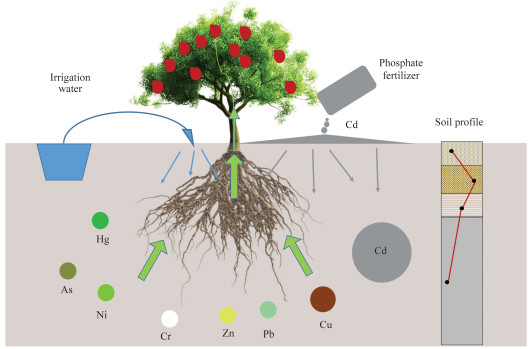
-
Keywords:
- agricultural park /
- soil /
- heavy metals /
- risk assessment /
- agricultural products /
- phosphate fertilizer
-
土地是一种极为重要、富有生命的有限资源,近年来我国部分地区土壤重金属污染问题日益凸显,已成为影响土地环境质量,进而影响农产品质量安全的突出问题[1]。以往的研究多数是以大尺度(1: 25万或更小比例尺采样密度)或中尺度(1: 5万比例尺采样密度)区域为研究对象,利用GIS和地统计学方法分析污染物的空间分布及迁移规律,而具体到某个地块范围的小尺度(大比例尺)研究较少。外源重金属进入土壤会导致重金属在小尺度上空间分异,因而大尺度和中尺度的调查研究结果不能有效地预测小尺度区域重金属空间分布特征及危害,其指导意义有限。在小尺度区域内研究农田土壤重金属空间分布特征和风险评价,对于准确掌握农田土壤污染状况、进行土地精准管理和指导农业生产具有重要的意义[2-3]。因而,在实际调查评价工作中,结合地方需求,开展小尺度农业园区土壤重金属分布特征及风险评价研究是十分必要的。
对于珠江三角洲,该区土壤重金属空间分布特征及风险评价的研究已有文献报道[4-8]。研究表明,珠江三角洲经济区土壤环境质量总体较好,一、二级土壤占总面积的77.2%。核心区域土壤重金属污染状况不容乐观,尤其是Cd、Hg、Pb、As、Ni、Cr等毒性重金属元素的污染面积大,强度高,其成因主要受地质作用和人为污染影响。本文在研究区进行详细踏勘的基础上,对该研究区土壤、灌溉水、典型农作物和主要使用的化肥进行采样分析,对重金属元素在典型土壤剖面上的垂向分布特征进行探究,采用地累积指数法和潜在生态危害指数法对研究区表层(0~20 cm)土壤重金属Cu、Pb、Zn、Cr、Ni、As、Hg、Cd污染程度进行评估,对污染源进行辨析,评价园区典型农产品对重金属元素的富集能力,以期为新马墩村农田生态环境保护、生态农业建设、可持续发展提供科学依据。
1. 实验部分
1.1 研究区概况
研究区位于珠海市新马墩村,以农业种植为主,规划发展生态农业,主要经营无公害水果蔬菜生产、岭南田园水乡风情体验,集农业观光、农业体验和乡村休闲度假功能于一体。该区为珠江三角洲平原地貌,海拔约2 m,属亚热带地区,季风性气候特征明显,终年气温较高,气候湿润,雨量充沛,年平均降雨量大于1600 mm。土壤发育在第四纪沉积物上,为海陆交互作用形成,表层土壤以含砂质黏土为主,土质疏松,灌溉水取自磨刀门水道,水源充足,园区复种指数高,地力消耗大。不少农户为了提高产量,存在过量使用化肥的习惯。
1.2 样品采集
2016年12月对研究区进行了实地调查和采样,采集研究区典型农产品可食部分样品8件(白菜2件、无花果2件、天冬2件、青枣1件、火龙果1件),每件植物样品为3~5份相同植物混合成一个样品。采集与制备方法参照生态地球化学评价动植物样品分析方法(DZ/T 0253—2014),用自来水将采集的植物可食部分样品多次冲洗干净后,再用蒸馏水冲洗干净,晾干,称其鲜样质量,捣碎,置于60℃烘箱烘干。烘干样用高速破碎机制成粉状,用纸袋外套塑料袋封装保存。
采集表层(0~20 cm)土壤样品10件,按照地块及种植作物特征,将3~5个点土壤样品混为一个样品。采集与制备方法参照土地质量地球化学评价规范(DZ/T 0295—2016),每个样品1 kg。
选取研究区桑果园、火龙果园、蔬菜基地、葡萄园4个土壤剖面,剖面柱状图如图 1所示,采集土壤剖面样品共计18件,用以探究重金属元素在垂向不同深度分布特征及垂向不同深度土壤颗粒组成特征。土壤剖面样品的采样长度间隔依据钻孔不同深度岩性特征,将钻孔柱状样品按照岩性进行分层采样,将同一层样品均匀化后取重金属元素分析样及颗粒分析样,每一层取样约2 kg,其中1 kg供重金属元素含量分析用,另1 kg供颗粒分析用。
依据水质采样技术指导(HJ494—2009)及水质采样样品的保存和管理技术规定(HJ493—2009),采集研究区灌溉水渠水样4件,各1000 mL。采集研究区使用量较大的化肥(磷肥、尿素、复合肥)样品6件,每件样品1 kg。研究区采样点分布如图 2所示。
1.3 样品分析
农作物、化肥样品分析:由广东省地质实验测试中心承担。农作物样品测试指标为Cu、Pb、Zn、Cr、Ni、As、Hg、Cd,测试方法参照生态地球化学评价动植物样品分析方法(DZ/T 0253—2014)。Cu、Pb、Zn、Cr、Ni、As、Cd采用DRC-e型电感耦合等离子体质谱仪(美国PerkinElmer公司)测定;Hg采用XGY-1011A型原子荧光光度计(廊坊开元公司)测定。化肥样品测试指标为Cd,测试方法参照肥料中As、Cd、Pb、Cr、Hg生态指标(GB/T 23349—2009),测试仪器为AA800型原子吸收光谱仪(美国PerkinElmer公司)。
土壤样品分析:由中南矿产资源监督检测中心承担。测试指标为Cu、Pb、Zn、Cr、Ni、As、Hg、Cd、pH,测试方法参照土壤环境监测技术规范测定(HJ/T 166—2004)。As、Hg采用AFS-230E型原子荧光分光光度计(北京海光仪器有限公司)测定;Cu、Pb、Zn、Cr、Ni、Cd采用XⅡ型电感耦合等离子体质谱仪(美国ThermoFisher公司)测定;pH采用pHs-2F型酸度计测定。
灌溉水样品分析:由中南矿产资源监督检测中心承担。测试指标为Cu、Pb、Zn、Cr、Ni、As、Hg、Cd。其中Cu、Pb、Zn、Cr、Ni、Cd参照水质65种元素的测定电感耦合等离子体质谱法测定(HJ700—2014),测试仪器为Ⅻ型电感耦合等离子体质谱仪(美国ThermoFisher公司),As、Hg参照水质汞、砷、硒、铋和锑的原子荧光光谱法(HJ694—2014)测定,测试仪器为AFS-230E型原子荧光分光光度计(北京海光仪器有限公司)。
所有样品均送至已通过国家计量认证的检测实验室进行分析检测,分析方法为国家或行业标准方法,并且在检测实验室的资质认定范围内。样品测试时,严格按照国家或行业标准进行质量控制,包括插入国家标准物质、样品加标回收、抽取密码重复样和空白试验。质量控制严格按照《多目标区域地球化学调查规范(1: 250000)》(DZ/T 0258—2014)和《生态地球化学评价样品分析技术要求》(DD2005—03)中关于分析过程准确度、精密度和空白试验的要求进行并满足规范要求。
1.4 表层土壤地积累指数评价
地积累指数(Igeo)通常称为Muller指数[9],是利用某一种重金属的含量与其地球化学背景值的关系来确定重金属污染程度的定量指标,不仅考虑了自然地质过程造成的背景值的影响,而且充分注意了人为活动对重金属污染的影响。该指数被广泛应用于重金属污染的评价,其表达公式为:
$ {I_{{\rm{geo}}}} = {\log _2}^{\left[ {{C_{\rm{i}}}/K{B_{_{\rm{i}}}}} \right]} $
式中:Ci为元素i在土壤中的浓度(mg/kg);Bi为沉积物中该元素的地球化学背景值(mg/kg),本研究选择珠江三角洲土壤背景值(DB/T 1415—2014)作为参照值;K是为考虑各地岩石差异可能会引起背景值的变动而取的系数(一般取值为K=1.5)。
地积累指数可分为7个级别:Igeo < 0,污染级别为0级,表示无污染;0≤Igeo < 1,污染级别为1级,表示无污染到中度污染;1≤Igeo < 2,污染级别为2级,表示中度污染;2≤Igeo < 3,污染级别为3级,表示中度污染到强污染;3≤Igeo < 4,污染级别为4级,表示强污染;4≤Igeo < 5,污染级别为5级,表示强污染到极强污染;Igeo≥5,污染级别为6级,表示极强污染。
1.5 表层土壤重金属污染潜在生态危害评价方法
瑞典学者Hakanson于1980年提出了潜在生态危害综合指数法(RI)[10],该方法是根据重金属性质及环境行为特点,从沉积学角度提出来的,考虑了土壤重金属含量,并将重金属的生态效应、环境效应与毒理学联系在一起。它不仅反映了某一特定环境中各种污染物对环境的影响及多种污染物的综合效应,而且用定量的方法划分出潜在生态风险的程度,因而得到非常广泛的应用。计算方法为:
$ RI = \Sigma {E_{\rm{i}}} = {T_{\rm{i}}}\left( {C_{\rm{s}}^{\rm{i}}/C_{\rm{n}}^{\rm{i}}} \right) $
式中:RI为多种重金属潜在生态危害综合指数,Ei为重金属i的潜在生态危害系数,Ei和RI的分级标准参照文献[11]。Ti为重金属i的毒性系数,此值反映了该种重金属的毒性水平,据Hakanson的元素丰度原则与元素释放度原则标准化重金属毒性系数,取Hg=40,Cd=30,As=10,Cu、Pb、Ni=5,Cr=2,Zn=1;Csi为重金属i的实测含量(mg/kg);Cni为重金属i的参比值(mg/kg),本研究采用珠江三角洲土壤背景值。
2. 结果与讨论
2.1 表层土壤和灌溉水重金属含量水平
研究区表层土壤重金属含量、pH值描述性统计分析结果列于表 1。该研究区表层土壤的pH值在7.64~8.30之间,呈碱性。与土壤环境质量一级标准值及珠江三角洲土壤背景值对比,研究区表层土壤中Cu、Pb、Zn、Cr、Ni、As、Hg等7种重金属元素含量平均值、中位值均低于土壤环境质量一级标准值和珠江三角洲土壤背景值,仅Cd元素含量平均值、中位值高于土壤环境质量一级标准值及珠江三角洲土壤背景值,但低于土壤环境二级标准值及珠江三角洲土壤污染风险筛选值。表层土壤Cd出现显著累积,其平均值是珠江三角洲土壤背景值的3.7倍,是国家土壤环境质量一级标准限值的2倍。在近1.2 km2小区域内,重金属元素Hg、Cd变异系数较大,显示出区域不同地块分布不均的特征。
表 1 研究区表层土壤重金属含量、pH值描述性统计(n=10)Table 1. Descriptive statistics of heavy metal concentrations and ph values in topsoil (n=10)测试项目 最小值(mg/kg) 最大值(mg/kg) 平均值(mg/kg) 中位数(mg/kg) 变异系数(%) 珠江三角洲土壤背景值(mg/kg) 珠江三角洲土壤污染风险筛选值(mg/kg) 土壤环境质量一级标准限值(mg/kg) 土壤环境质量二级标准限值(mg/kg) Cu 18.7 49.1 28.89 23.85 34 32 145 35 100 Pb 21 43.4 27.08 24.1 27 60 100 35 350 Zn 63.5 156 89.92 78.1 31 97 320 100 300 Cr 45 89.5 63.77 59.3 22 77 260 90 250 Ni 17.6 37.7 23.95 21.4 27 28 105 40 60 As 6.8 18.57 10.52 9.03 36 25 40 15 25 Hg 0.03 0.19 0.07 0.06 57 0.13 1 0.15 1 Cd 0.22 0.78 0.41 0.31 46 0.11 0.8 0.2 0.6 pH 7.64 8.30 7.99 7.99 3 - - - - 注: “-”表示无相关数值。 通过对园区灌溉水渠采集的水样Cu、Pb、Zn、Cr、Ni、As、Hg、Cd元素分析测试结果(表 2)统计,其含量较低,均达到GB5084—2005《农田灌溉水质标准》的要求。Ni含量低于地表水环境质量标准(GB3838—2002)中Ni含量限值(0.02 mg/L),达到地下水质量标准(GB/T 14848—2017)中的Ⅲ类水标准。
表 2 研究区灌溉水重金属含量及标准限值Table 2. Heavy metal concentrations in irrigation water and their standard limits灌溉水样品 重金属含量(mg/L) Cu Pb Zn Cr Ni As Hg Cd 灌溉水-1 0.0028 0.0003 0.031 0.0071 0.0035 0.0006 < 0.00005 < 0.0001 灌溉水-2 0.0023 0.0006 0.025 0.0097 0.0039 0.0011 < 0.00005 < 0.0001 灌溉水-3 0.0014 0.0003 - 0.001 - 0.0009 < 0.00005 < 0.0001 灌溉水-4 0.0035 0.0001 - 0.0017 - 0.0008 < 0.00005 < 0.0001 《农田灌溉水质标准》(GB5048—2005)限值 1 0.2 2 0.1(六价) - 0.05 0.001 0.01 注:“-”表示无相关数值。 2.2 土壤剖面不同深度重金属分布特征
依据土壤剖面不同深度岩性特征,将土壤剖面柱状样品按照岩性进行分层采样,园区桑果园、火龙果园、蔬菜基地、葡萄园采集的4个土壤剖面样品中Cu、Pb、Zn、Cr、Ni、As、Hg、Cd在垂向的分布如图 3所示。Cd、Hg含量数值较小,采用测试结果乘以100参与绘图,各剖面土壤颗粒组成如图 4所示。可以看出:8种重金属在4个土壤剖面中分布呈现出不同的特征。
在桑果园土壤剖面,8种重金属呈现出相同的特征,由浅入深,元素含量先变大后变小,最高值均出现在15~35 cm处,分布特征呈现出单峰模式。在火龙果园剖面,Cu、Pb、Zn、Ni、As、Hg、Cd分布特征相似,由浅入深,元素含量先变大后变小,最高值出现在60~130 cm处;Cr元素呈现出由浅入深逐渐变大的特征。在蔬菜基地剖面,Cu、Pb、Zn、Cr、Ni、As元素呈现出相似特征,由浅入深,先变大后变小,最高值出现在深度40~100 cm处;Hg元素呈现出先变小后变大的特征,最小值出现在深度40~100 cm处;Cd元素呈现出逐渐变小的特征;8种重金属元素在0~20 cm与20~40 cm处含量较均匀,显然是由于耕作扰动,使该深度内土壤被充分混合。在葡萄园剖面,由浅入深,Cu、Pb、Zn、Cr、Ni、As六种元素含量较均匀,变化不大;Hg元素在表层(0~20 cm)含量最大,在20 cm以下土层的含量相对稳定,变化较小;Cr元素呈现出由浅入深先变大后变小的特征,呈现出单峰模式,最高值出现在深度40~100 cm处。4个剖面中均以Cr、Zn元素含量最大。
将剖面土壤重金属含量与珠江三角洲土壤背景值比较,元素超标率由大到小的顺序为:Cd(100%)>Cu(67%)>Cr(61%)>Ni(50%)>Hg(39%)>Zn(33%)>Pb(11%)=As(11%)。另有三组土壤超过珠江三角洲土壤污染风险筛选值,且超标元素均为Cd,位于桑果园土壤剖面15~35 cm处和火龙果园土壤剖面20~60 cm、60~130 cm处,说明该园区土壤Cd不只是在表层含量高,在整个剖面上含量均较高,与文献[12-14]研究结果相一致,存在较高的生态安全风险,需关注园区土壤Cd含量较高的问题。
研究区4个典型土壤剖面均位于磨刀门水道附近,土壤为海陆交互作用形成,多发育于冲积、海积母质,土壤质地的不均匀性和岩性不连续性明显。从图 4可以看出该区域土壤剖面质地的差异较大,显示出不均匀特征,4个剖面粗粒土(粒径>0.075 mm)含量范围为9.9%~50.8%,变异系数35.63%。各剖面粗粒土含量平均占比为:葡萄园剖面(35.68%)>蔬菜基地剖面(32.46%)>火龙果园剖面(27.78%)>桑果园剖面(24.83%),各剖面粗粒土含量变异系数桑果园剖面(49.67%)>葡萄园剖面(39.60%)>火龙果园剖面(27.99%)>蔬菜基地剖面(23.90%)。土壤颗粒组成不同,会导致土壤砂黏性质不同,对重金属元素的吸附能力也就不同,粗粒土含量越高,重金属元素在剖面垂向迁移越容易,重金属元素在整个剖面上分布就越均匀[15-16]。研究区桑果园剖面粗粒土含量较其余三个剖面低,重金属元素向下迁移较慢,使得重金属元素在桑果园剖面垂向分布较不均匀,桑果园剖面各元素平均变异系数达到41.09%,其余三个剖面重金属含量垂向分布较均匀,各元素平均变异系数均小于27%。从图 1土壤剖面柱状图来看,不同土壤剖面同一深度岩性不完全相同,同一土壤剖面不同深度岩性也有差异,土壤黏重程度差异较大,显示出不连续性特征,而土壤中多数重金属元素含量与土壤质地的砂黏程度密切相关[15]。土壤质地的不均一性和岩性不连续性影响了重金属在研究区4个土壤剖面的分布特征。
2.3 表层土壤重金属污染程度和潜在生态危害评价
研究区表层土壤重金属Cu、Pb、Zn、Cr、Ni、As、Hg、Cd污染地积累指数(Igeo)分级情况列于表 3。从表中数据可以看出,研究区表层土壤Cd污染最严重,10个采样点中有1个达到中度污染到强污染级别(3级),3个达到中度污染级别(2级),6个为无污染到中度污染级别(1级)。Cu有1个为无污染到中度污染级别(1级)。Pb、Zn、Cr、Ni、As、Hg元素在各样点均无污染(0级)。从地积累指数平均值看,Cd处于中度污染级别,其余7种元素均处于无污染级别。
表 3 研究区表层土壤重金属污染地积累指数分级、潜在生态危害系数分级(n=10)Table 3. Classification of heavy metal pollution based on the Igeo and Ei in the topsoil地积累指数(Igeo)分级 Igeo各级样本数(个) Cu Pb Zn Cr Ni As Hg Cd 0级 9 10 10 10 10 10 10 0 1级 1 0 0 0 0 0 0 6 2级 0 0 0 0 0 0 0 3 3级 0 0 0 0 0 0 0 1 4级 0 0 0 0 0 0 0 0 5级 0 0 0 0 0 0 0 0 6级 0 0 0 0 0 0 0 0 Igeo均值 -0.8 -1.77 -0.75 -0.89 -0.85 -1.91 -1.57 1.17 潜在生态危害系数(Ei)分级 Ei各级样本数(个) Cu Pb Zn Cr Ni As Hg Cd 轻微危害 10 10 10 10 10 10 9 0 中等危害 0 0 0 0 0 0 1 4 强危害 0 0 0 0 0 0 0 3 很强危害 0 0 0 0 0 0 0 3 极强危害 0 0 0 0 0 0 0 0 Ei均值 4.51 1.91 0.93 1.66 4.28 4.21 22.89 111 研究区表层土壤重金属Cu、Pb、Zn、Cr、Ni、As、Hg、Cd的潜在生态危害系数(Ei)列于表 3。从评价结果可以看出,研究区表层土壤中Cu、Pb、Zn、Cr、Ni、As元素在所有10个样点均处在轻微生态危害,Hg有1个处在中等生态危害。Cd的生态危害性最大,10个采样点,中等生态危害有4个,强生态危害有3个,很强生态危害有3个。从8种元素的平均值来看,Cd处于强生态危害程度,其余7种元素均处于轻微生态危害程度。研究区表层土壤8种重金属潜的生态危害程度由强到弱的顺序依次为:Cd>Hg>Cu>Ni>As>Pb>Cr>Zn。
基于各元素含量平均值计算得到的表层土壤多种重金属潜在生态危害综合指数RI=151.37,总体处于中等生态危害程度,其中Cd对RI值的贡献最大。通过计算10个样点的多种重金属潜在生态危害综合指数RI,有7个样点总体处于轻微生态危害程度,有2个样点总体处于中等生态危害程度,有1个样点整体处于强生态危害程度。
研究区表层土壤重金属污染地积累指数评价和潜在生态危害系数评价结果表明,研究区表层土壤主要以Cd污染为主,其余重金属元素污染较轻,与文献[17-18]报道相符。赖启宏等[12]认为在西江和北江冲积平原存在Cd的高含量分布区,是地质成因引起,由富含Cd的西江和北江冲积物在珠江三角洲沉积而成。刘子宁等[13]认为珠江三角洲东南部濒海区第四纪沉积物Cd的含量分布受控于温暖湿润、海陆交互作用强烈的沉积环境。从本次园区小范围土壤Cd含量统计分析获得表层土壤样品中Cd含量较高,局部点位Cd含量高于文献[12-13]报道值,且变异系数较大(46%),显示出区域不同地块分布不均匀的特征,说明土壤Cd的高含量除了受控于地质作用、环境条件外,还可能受到外在人为因素的影响。文献报道农田土壤镉污染主要来自含镉矿石的开采、选冶以及含镉的工业“三废”排放[19]、污水灌溉[20-21]、含镉化肥的使用[22-24]。该研究区附近周边无矿石的开采、选冶加工活动,无相关重金属污染排放企业。根据采集的灌溉水渠水质Cd含量分析测试结果(表 2),其Cd含量均小于0.0001 mg/L,远低于《农田灌溉水质标准》(GB 5084—2005)的Cd限值0.01 mg/L。
调查发现,该园区种植长期大量施用含Cd化肥(磷肥、尿素、复合肥),造成了农田土壤镉的累积。化肥样品Cd分析结果显示:磷肥Cd平均值20.5 mg/kg;复合肥Cd平均值1.30 mg/kg,尿素Cd平均值0.03 mg/kg,其中磷肥中Cd含量超过标准GB/T 23349—2009限值(10 mg/kg)。磷肥中的Cd含量较高,在园区部分地块使用量也较大,是该园区土壤Cd的主要来源之一。通过对比不同地块表层土壤样品Cd环境质量分级(《土壤环境质量标准》,GB 15618—1995)与其种植作物及各地块主要使用的化肥特征情况,发现园区各地块表层土壤Cd环境质量均为Ⅱ、Ⅲ类土壤。青枣地块、桑果园地块表层土壤Cd超标严重,达到Ⅲ类土壤(图 2)。在以施用磷肥为主的地块(青枣地块、桑果园地块),表层土壤Cd超标较严重,其余地块以施用尿素、复合肥、有机肥为主,表层土壤Cd含量相对较低。为此,建议园区应重视表层土壤镉潜在生态风险问题,减少磷肥使用量,通过调整化肥使用结构、轮耕、休耕等方式,预防、减轻和避免土壤镉对种植作物、生态环境和人体健康的影响。
2.4 典型农产品的重金属水平及重金属富集能力
为进一步分析研究区农田潜在生态风险水平,采集研究区典型农产品可食部分样品8件(白菜2件、无花果2件、天冬2件、青枣1件、火龙果1件),测试了其中8种重金属含量。对研究区采集的农产品可食部分样品进行测试、统计分析与评价,以《食品安全国家标准—食品中污染物限量》(GB 2762—2017)为参照,评价结果表明供试样品重金属Cu、Pb、Cr、Ni、As、Hg、Cd含量均未超标;因标准中无Zn的限量值,未对其进行评价。
将农产品重金属含量与对应点土壤的重金属含量进行对比分析,探讨研究区典型农产品对重金属元素的富集能力[25]。农产品对土壤某种元素的富集系数=农产品中某种元素的浓度(mg/kg)/该元素在土壤中的浓度(mg/kg),研究区典型农产品的富集系数的统计结果列于表 4。不同种类农产品的可食部分对不同元素的富集能力存在显著差异。对As的富集能力为:白菜>无花果>青枣、火龙果、天冬;对Cd的富集能力为:白菜>无花果>天冬>火龙果>青枣;对Cr的富集能力为:火龙果>白菜>青枣、天冬、无花果;对Cu的富集能力为:天冬>无花果>火龙果>青枣>白菜;对Hg的富集能力为:白菜>无花果>天冬>青枣、火龙果;对Ni的富集能力为:火龙果>无花果>白菜>天冬>青枣;对Pb的富集能力为:白菜>无花果>火龙果>天冬>青枣。
表 4 研究区典型农产品重金属含量及其富集系数(n=10)Table 4. Heavy metal contents of typical agricultural products in the research area and their enrichment factors农产品 Cu Pb Cr Ni As Hg Cd 含量(mg/kg) 富集系数 含量(mg/kg) 富集系数 含量(mg/kg) 富集系数 含量(mg/kg) 富集系数 含量(mg/kg) 富集系数 含量(mg/kg) 富集系数 含量(mg/kg) 富集系数 无花果-1 0.52 0.0229 0.01 0.00045 <0.05 - 0.09 0.00465 0.09 0.00465 <0.01 - <0.0005 - 无花果-2 0.56 0.02466 0.02 0.0009 <0.05 - 0.23 0.01189 0.23 0.01189 0.01 0.00113 0.0007 0.01104 青枣 0.51 0.01297 0.01 0.00028 <0.05 - 0.04 0.0013 0.04 0.00130 <0.01 - <0.0005 - 白菜-1 0.24 0.01057 0.02 0.00086 <0.05 - 0.12 0.00579 0.12 0.00579 <0.01 - 0.0006 0.01266 白菜-2 0.31 0.01365 0.03 0.00124 0.07 0.00129 0.16 0.00773 0.16 0.00773 0.02 0.00251 0.0009 0.01899 天冬-1 1.06 0.04667 0.01 0.00045 <0.05 - 0.07 0.00362 0.07 0.00362 <0.01 - 0.0006 0.00946 天冬-2 1.36 0.05987 0.01 0.00043 <0.05 - 0.12 0.0062 0.12 0.00620 <0.01 - 0.0006 0.00946 火龙果 0.84 0.02374 0.02 0.00066 0.38 0.00525 0.45 0.01743 0.45 0.01743 <0.004 - <0.0005 - 《食品中污染物限量》(GB 2762—2017) - 水果0.1
蔬菜0.3蔬菜0.5 - 蔬菜0.5 蔬菜0.01 水果0.05
蔬菜0.2注:“-”表示无相关数据。 以上5种典型农作物相比较,白菜、无花果对重金属的富集能力较强,青枣、火龙果、天冬富集能力较弱。以农产品中各重金属富集系数的平均值计算,重金属的富集系数依次为:Cd>Cu>Hg>Ni>Cr>As>Pb。为此,提出园区应优先种植青枣、火龙果、天冬等对重金属富集能力较低的品种,以降低土壤中重金属对农产品品质的影响,同时重视镉潜在生态风险问题。
3. 结论
对新马墩村农业园区土壤、灌溉水、典型农作物、主要施用化肥中的8种重金属进行分析测定,并用地积累指数法和潜在生态危害指数法对土壤重金属污染进行评价。研究表明,表层土壤Cd处于中度污染级别,强生态危害程度,变异系数达到46%,其余7种重金属危害程度轻微。表层土壤高含量Cd受人为因素影响较大,与长期大量施用含镉化肥有关,尤其是磷肥。8种重金属元素在不同土壤剖面中分布呈现出不同的特征,主要受土壤质地不均一性、岩性不连续性的影响。灌溉水和5种典型农作物可食部分重金属均未超标,白菜、无花果对重金属的富集能力较强,青枣、火龙果、天冬的富集能力较弱。建议园区优先种植青枣、火龙果、天冬等对重金属富集能力较弱的品种,以降低土壤中重金属对农产品品质的影响,同时应重视土壤镉潜在生态风险问题,调整化肥使用结构,减少含镉磷肥使用量。
-
表 1 研究区表层土壤重金属含量、pH值描述性统计(n=10)
Table 1 Descriptive statistics of heavy metal concentrations and ph values in topsoil (n=10)
测试项目 最小值(mg/kg) 最大值(mg/kg) 平均值(mg/kg) 中位数(mg/kg) 变异系数(%) 珠江三角洲土壤背景值(mg/kg) 珠江三角洲土壤污染风险筛选值(mg/kg) 土壤环境质量一级标准限值(mg/kg) 土壤环境质量二级标准限值(mg/kg) Cu 18.7 49.1 28.89 23.85 34 32 145 35 100 Pb 21 43.4 27.08 24.1 27 60 100 35 350 Zn 63.5 156 89.92 78.1 31 97 320 100 300 Cr 45 89.5 63.77 59.3 22 77 260 90 250 Ni 17.6 37.7 23.95 21.4 27 28 105 40 60 As 6.8 18.57 10.52 9.03 36 25 40 15 25 Hg 0.03 0.19 0.07 0.06 57 0.13 1 0.15 1 Cd 0.22 0.78 0.41 0.31 46 0.11 0.8 0.2 0.6 pH 7.64 8.30 7.99 7.99 3 - - - - 注: “-”表示无相关数值。 表 2 研究区灌溉水重金属含量及标准限值
Table 2 Heavy metal concentrations in irrigation water and their standard limits
灌溉水样品 重金属含量(mg/L) Cu Pb Zn Cr Ni As Hg Cd 灌溉水-1 0.0028 0.0003 0.031 0.0071 0.0035 0.0006 < 0.00005 < 0.0001 灌溉水-2 0.0023 0.0006 0.025 0.0097 0.0039 0.0011 < 0.00005 < 0.0001 灌溉水-3 0.0014 0.0003 - 0.001 - 0.0009 < 0.00005 < 0.0001 灌溉水-4 0.0035 0.0001 - 0.0017 - 0.0008 < 0.00005 < 0.0001 《农田灌溉水质标准》(GB5048—2005)限值 1 0.2 2 0.1(六价) - 0.05 0.001 0.01 注:“-”表示无相关数值。 表 3 研究区表层土壤重金属污染地积累指数分级、潜在生态危害系数分级(n=10)
Table 3 Classification of heavy metal pollution based on the Igeo and Ei in the topsoil
地积累指数(Igeo)分级 Igeo各级样本数(个) Cu Pb Zn Cr Ni As Hg Cd 0级 9 10 10 10 10 10 10 0 1级 1 0 0 0 0 0 0 6 2级 0 0 0 0 0 0 0 3 3级 0 0 0 0 0 0 0 1 4级 0 0 0 0 0 0 0 0 5级 0 0 0 0 0 0 0 0 6级 0 0 0 0 0 0 0 0 Igeo均值 -0.8 -1.77 -0.75 -0.89 -0.85 -1.91 -1.57 1.17 潜在生态危害系数(Ei)分级 Ei各级样本数(个) Cu Pb Zn Cr Ni As Hg Cd 轻微危害 10 10 10 10 10 10 9 0 中等危害 0 0 0 0 0 0 1 4 强危害 0 0 0 0 0 0 0 3 很强危害 0 0 0 0 0 0 0 3 极强危害 0 0 0 0 0 0 0 0 Ei均值 4.51 1.91 0.93 1.66 4.28 4.21 22.89 111 表 4 研究区典型农产品重金属含量及其富集系数(n=10)
Table 4 Heavy metal contents of typical agricultural products in the research area and their enrichment factors
农产品 Cu Pb Cr Ni As Hg Cd 含量(mg/kg) 富集系数 含量(mg/kg) 富集系数 含量(mg/kg) 富集系数 含量(mg/kg) 富集系数 含量(mg/kg) 富集系数 含量(mg/kg) 富集系数 含量(mg/kg) 富集系数 无花果-1 0.52 0.0229 0.01 0.00045 <0.05 - 0.09 0.00465 0.09 0.00465 <0.01 - <0.0005 - 无花果-2 0.56 0.02466 0.02 0.0009 <0.05 - 0.23 0.01189 0.23 0.01189 0.01 0.00113 0.0007 0.01104 青枣 0.51 0.01297 0.01 0.00028 <0.05 - 0.04 0.0013 0.04 0.00130 <0.01 - <0.0005 - 白菜-1 0.24 0.01057 0.02 0.00086 <0.05 - 0.12 0.00579 0.12 0.00579 <0.01 - 0.0006 0.01266 白菜-2 0.31 0.01365 0.03 0.00124 0.07 0.00129 0.16 0.00773 0.16 0.00773 0.02 0.00251 0.0009 0.01899 天冬-1 1.06 0.04667 0.01 0.00045 <0.05 - 0.07 0.00362 0.07 0.00362 <0.01 - 0.0006 0.00946 天冬-2 1.36 0.05987 0.01 0.00043 <0.05 - 0.12 0.0062 0.12 0.00620 <0.01 - 0.0006 0.00946 火龙果 0.84 0.02374 0.02 0.00066 0.38 0.00525 0.45 0.01743 0.45 0.01743 <0.004 - <0.0005 - 《食品中污染物限量》(GB 2762—2017) - 水果0.1
蔬菜0.3蔬菜0.5 - 蔬菜0.5 蔬菜0.01 水果0.05
蔬菜0.2注:“-”表示无相关数据。 -
张桃林.加强土壤和产地环境管理促进农业可持续发展[J].中国科学院院刊, 2015, 30(4):435-444. http://www.wanfangdata.com.cn/details/detail.do?_type=perio&id=665484042 Zhang T L.Strengthening soil and environment manage-ment of magricultural producing area, promoting sustainable development of agriculture in China[J].Bulletin of Chinese Academy of Sciences, 2015, 30(4):435-444. http://www.wanfangdata.com.cn/details/detail.do?_type=perio&id=665484042
金修齐, 王朋, 郭秉林, 等.小尺度农田土壤Pb、Zn和Cd空间分布及污染评价——以云南沘江沿岸某农田为例[J].环境工程学报, 2017, 11(11):6190-6195. doi: 10.12030/j.cjee.201608098 Jin X Q, Wang P, Guo B L, et al.Spatial distribution and pollution assessment of Pb, Zn and Cd in small scale farmland soil-A case study of a farmland along the Bijiang River in Yunnan Province[J].Chinese Journal of Environmental Engineering, 2017, 11(11):6190-6195. doi: 10.12030/j.cjee.201608098
李小曼, 刘勤, 徐梦洁, 等.苏南村镇土壤重金属空间变异性研究[J].土壤通报, 2016, 47(1):179-185. http://d.old.wanfangdata.com.cn/Periodical/trtb201601028 Li X M, Liu Q, Xu M J, et al.Spatial variability of heavy metal contents in towns of Southern Jiangsu Province[J].Chinese Journal of Soil Science, 2016, 47(1):179-185. http://d.old.wanfangdata.com.cn/Periodical/trtb201601028
李婷婷, 刘子宁, 朱鑫, 等.珠三角地区土壤重金属元素异常来源浅析及其环境质量评价[J].国土资源导刊, 2016, 13(2):30-35. doi: 10.3969/j.issn.1672-5603.2016.02.006 Li T T, Liu Z N, Zhu X, et al.Origin of heavy metal element anomalies in soils of the Pearl River Delta and its environmental quality assessment[J].Land & Resources Herald, 2016, 13(2):30-35. doi: 10.3969/j.issn.1672-5603.2016.02.006
Dou L, Li T.Regional geochemical characteristics and influence factors of soil elements in the Pearl River Delta Economic Zone, China[J].International Journal of Geosciences, 2015, 6(6):593-604. doi: 10.4236/ijg.2015.66046
Dou L, Shen S Z, Du H Y.Distributional characteristics and sources of elements in soil from typical area of Pearl River Delta Economic Zone, Guangdong Province, China[J].Chinese Journal of Geochemistry, 2015, 34(3):299-310. doi: 10.1007/s11631-015-0048-4
宗庆霞, 窦磊, 侯青叶, 等.基于土地利用类型的土壤重金属区域生态风险评价:以珠江三角洲经济区为例[J].地球科学进展, 2017, 32(8):875-884. http://d.old.wanfangdata.com.cn/Periodical/dqkxjz201708011 Zong Q X, Dou L, Hou Q Y, et al.Regional ecological risk assessment of soil heavy metals in Pearl River Delta Economic Zone based on different land uses[J].Advances in Earth Science, 2017, 32(8):875-884. http://d.old.wanfangdata.com.cn/Periodical/dqkxjz201708011
Zhang L, Guo S, Wu B.The source, spatial distribution and risk assessment of heavy metals in soil from the Pearl River Delta based on the national multi-purpose regional geochemical survey[J].Plos One, 2015, 10(7):1-12. doi: 10.1371/journal.pone.0132040
Muller G.Index of geoaccumulation in sediments of the Rhine River[J].Geojournal, 1969, 2(3):109-118. http://en.journals.sid.ir/ViewPaper.aspx?ID=329476
Hakanson L.An ecological risk index for aquatic pollu-tion control:A sedimentological approach[J].Water Research, 1980, 14(8):975-1001. doi: 10.1016/0043-1354(80)90143-8
赵庆令, 李清彩, 谢江坤, 等.应用富集系数法和地累积指数法研究济宁南部区域土壤重金属污染特征及生态风险评价[J].岩矿测试, 2015, 34(1):129-137. doi: 10.15898/j.cnki.11-2131/td.2015.01.017 Zhao Q L, Li Q C, Xie J K, et al.Characteristics of soil heavy metal pollution and its ecological risk assessment in South Jining district using methods of enrichment factor and index of geoaccumulation[J].Rock and Mineral Analysis, 2015, 34(1):129-137. doi: 10.15898/j.cnki.11-2131/td.2015.01.017
赖启宏, 杜海燕, 方敬文, 等.珠江三角洲冲积平原土壤镉高含量区形成原因[J].农业环境科学学报, 2005, 24(4):746-750. doi: 10.3321/j.issn:1672-2043.2005.04.030 Lai Q H, Du H Y, Fang J W, et al.Source and cause of regional Cd enrichment in alluvial soils in the Pearl River Delta Plain[J].Journal of Agro-Environment Science, 2005, 24(4):746-750. doi: 10.3321/j.issn:1672-2043.2005.04.030
刘子宁, 窦磊, 张伟.珠江三角洲第四纪沉积物Cd元素的分布特征及成因[J].地质通报, 2012, 31(1):172-180. doi: 10.3969/j.issn.1671-2552.2012.01.022 Liu Z N, Dou L, Zhang W.Distribution and origin of cadmium in the Quaternary sediments of the Pearl River Delta Plain, Guangdong Province, Southern China[J].Geological Bulletin of China, 2012, 31(1):172-180. doi: 10.3969/j.issn.1671-2552.2012.01.022
唐志敏, 侯青叶, 游远航, 等.珠三角平原区第四系剖面重金属分布特征及其影响因素[J].地球科学进展, 2017, 32(8):885-898. http://d.old.wanfangdata.com.cn/Periodical/dqkxjz201708012 Tang Z M, Hou Q Y, You Y H, et al.Distribution characteristics and influencing factors of heavy metals in Pearl River Delta Quaternary boreholes[J].Advances in Earth Science, 2017, 32(8):885-898. http://d.old.wanfangdata.com.cn/Periodical/dqkxjz201708012
赵赟. 西湖景区植物-土壤系统重金属的空间分布特征及其影响因子[D]. 杭州: 浙江大学, 2013. Zhao Y. Spatial Distribution and Impact Factors of Heavy Metals in Plant-Soil System in West Lake Scenic Area[D]. Hangzhou: Zhejiang University, 2013.
李向宏, 王艳红, 郑国璋.临汾盆地农田褐土剖面重金属的分布迁移特征[J].河北师范大学学报(自然科学版), 2016(2):168-171. http://www.cnki.com.cn/Article/CJFDTOTAL-HBSZ201602015.htm Li X H, Wang Y H, Zheng G Z.Distribution and migration characteristics of heavy metal elements in profile of cinnamon soil in farmland of Linfen Basin[J].Journal of Hebei Normal University (Natural Science Edition), 2016(2):168-171. http://www.cnki.com.cn/Article/CJFDTOTAL-HBSZ201602015.htm
林荣誉, 苏结雯, 吴灵.珠海市农用地土壤重金属污染情况调查[J].资源节约与环保, 2016(8):180-181. doi: 10.3969/j.issn.1673-2251.2016.08.146 Lin R Y, Su J W, Wu L.Investigation of heavy metal pollution in soil of agricultural land in Zhuhai[J].Resources Economization & Environmental Protection, 2016(8):180-181. doi: 10.3969/j.issn.1673-2251.2016.08.146
Geng J, Wang Y, Luo H.Distribution, sources, and fluxes of heavy metals in the Pearl River Delta, South China[J].Marine Pollution Bulletin, 2015, 101(2):914-921. doi: 10.1016/j.marpolbul.2015.10.066
徐友宁, 张江华, 柯海玲, 等.某金矿区农田土壤镉污染及其环境效应[J].中国地质, 2013, 40(2):636-643. doi: 10.3969/j.issn.1000-3657.2013.02.027 Xu Y N, Zhang J H, Ke H L, et al.Cd contamination of farmland soil in a gold mining area and its environmental effects[J].Geology in China, 2013, 40(2):636-643. doi: 10.3969/j.issn.1000-3657.2013.02.027
Li Y, Wang S, Prete D, et al.Accumulation and inter-action of fluoride and cadmium in the soil-wheat plant system from the wastewater irrigated soil of an oasis region in Northwest China[J].Science of the Total Environment, 2017, 595:344-351. doi: 10.1016/j.scitotenv.2017.03.288
张萌, 毋燕妮, 解静芳, 等.太原市污灌区土壤镉存在形态与生物可利用性研究[J].环境科学学报, 2015, 35(10):3276-3283. http://d.old.wanfangdata.com.cn/Periodical/hjkxxb201510032 Zhang M, Wu Y N, Xie J F, et al.Chemical speciation and bioavailability of cadmium in sewage-irrigated farm soils in Taiyuan[J].Acta Science Circumstantiae, 2015, 35(10):3276-3283. http://d.old.wanfangdata.com.cn/Periodical/hjkxxb201510032
Xiang L L, Noura Z D, Gilles B, et al.Cadmium accu-mulation in wheat grain as affected by mineral N fertilizer and soil characteristics[J].Canadian Journal of Soil Science, 2011, 91(4):521-531. doi: 10.4141/cjss10061
Wang Q Y, Zhang J, Zhao B Z, et al.The influence of long-term fertilization on cadmium (Cd) accumulation in soil and its uptake by crops[J].Environmental Science and Pollution Research, 2014, 21(17):10377-10385. doi: 10.1007/s11356-014-2939-z
徐一兰, 金自力, 刘唐兴, 等.不同施肥措施对双季稻田土壤和大麦植株镉累积的影响[J].生态环境学报, 2017, 26(7):1235-1241. http://d.old.wanfangdata.com.cn/Periodical/tryhj201707021 Xu Y L, Jin Z L, Liu T X, et al.Effects of long-term fertilization on heavy metal Cd accumulation in the surface soil and barley plant of double-cropping paddy rice system[J].Ecology and Environmental Sciences, 2017, 26(7):1235-1241. http://d.old.wanfangdata.com.cn/Periodical/tryhj201707021
王腾云, 周国华, 孙彬彬, 等.福建沿海地区土壤-稻谷重金属含量关系与影响因素研究[J].岩矿测试, 2016, 35(3):295-301. doi: 10.15898/j.cnki.11-2131/td.2016.03.013 Wang T Y, Zhou G H, Sun B B.et al.The relationship between heavy metal contents of soils and rice in coastal areas, Fujian Province, including influencing factors[J].Rock and Mineral Analysis, 2016, 35(3):295-301. doi: 10.15898/j.cnki.11-2131/td.2016.03.013
-
期刊类型引用(3)
1. 付永东. 绿色地质矿产资源勘查及开采技术研究. 西部资源. 2024(01): 116-119 .  百度学术
百度学术
2. 王成辉,王登红,刘善宝,张永生,王春连,王九一,周雄,代鸿章,于扬,孙艳,邢恩袁. 战略新兴矿产调查工程进展与主要成果. 中国地质调查. 2022(05): 1-14 .  百度学术
百度学术
3. 龚磊,王新峰,宋绵,胡啟锋,缪赛,陈浩习. 江西兴国县潜在偏硅酸矿泉水水化学特征及水质健康功能评价. 岩矿测试. 2021(06): 894-906 .  本站查看
本站查看
其他类型引用(1)



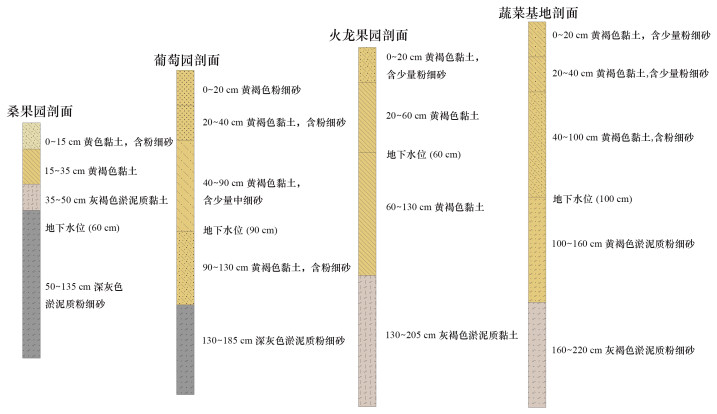
 下载:
下载:
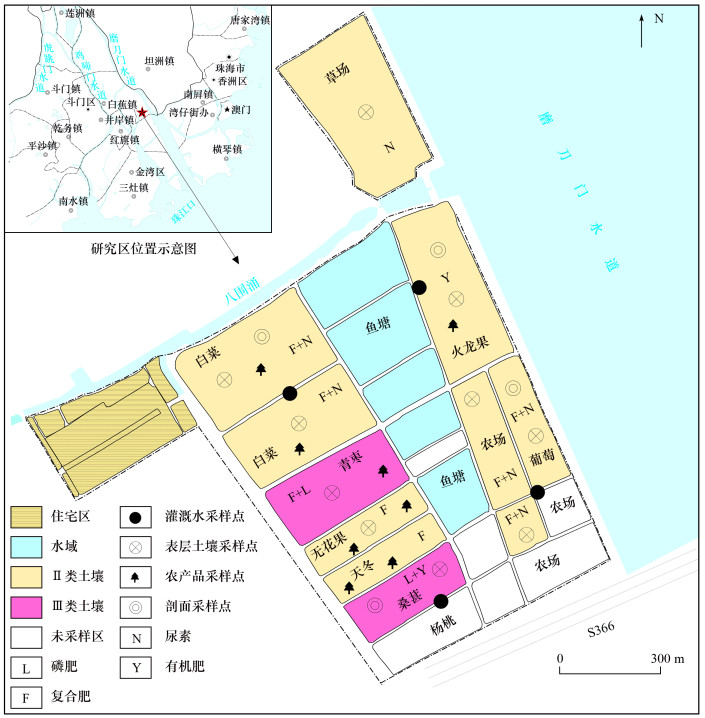
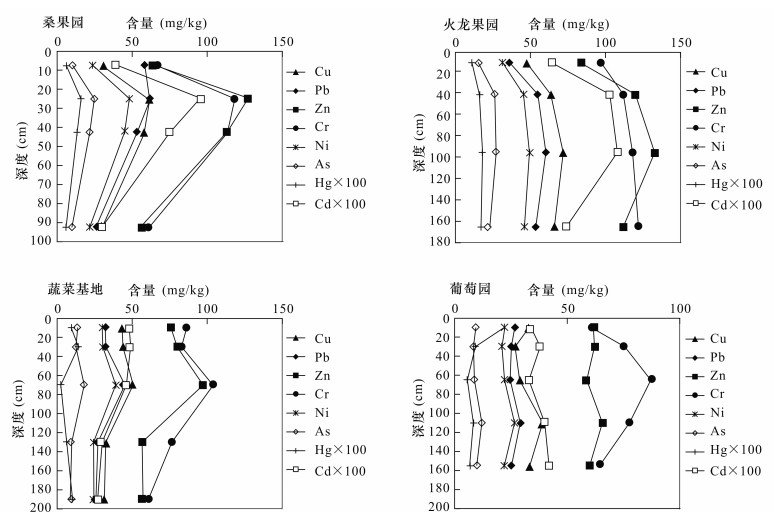
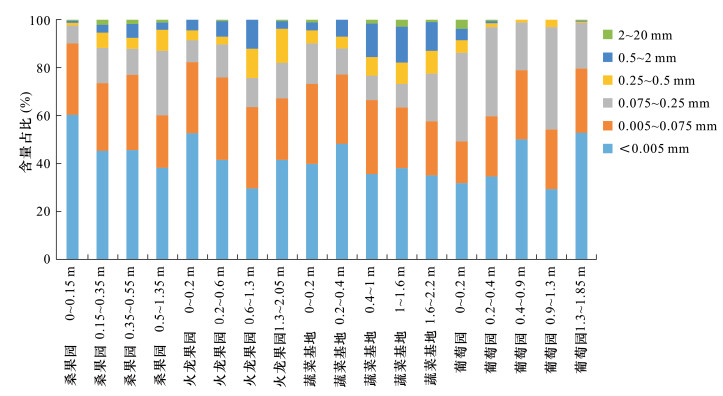
 京公网安备 11010202008159号
京公网安备 11010202008159号